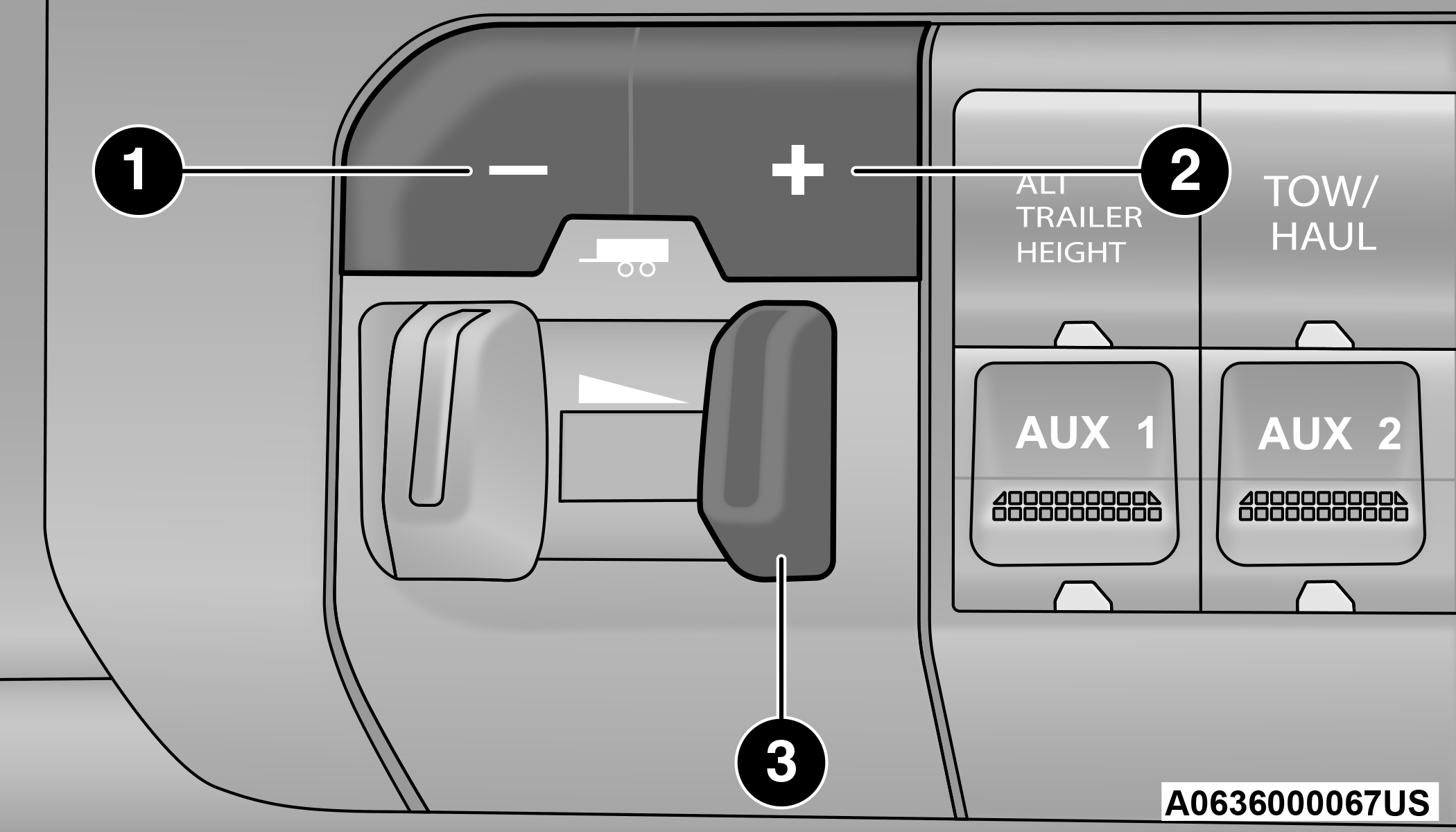Your vehicle may have an ITBM for Electric and Electric Over Hydraulic (EOH) trailer brakes.
This module has been designed and verified with electric trailer brakes and new electric over hydraulic systems. Some previous EOH systems may not be compatible with ITBM.

Integrated Trailer Brake Module (ITBM)
|
1 — GAIN Adjustment Button |
|
2 — GAIN Adjustment Button |
|
3 — Manual Brake Control Lever |
The user interface consists of the following:
Manual Brake Control Lever
Slide the manual brake control lever to the left to activate power to the trailer's electric brakes independent of the tow vehicle's brakes. If the manual brake control lever is activated while the brake is also applied, the greater of the two inputs determines the power sent to the trailer brakes.
The trailer and the vehicle’s stop lamps will come on when braking normally with the vehicle brake pedal. Only the trailer stop lamps will come on when the manual brake control lever is applied.
Trailer Brake Status Indicator Light
This light indicates the trailer electrical connection status.
If no electrical connection is detected after the ignition is turned on, pushing the GAIN adjustment button or sliding the manual brake control lever will display the GAIN setting for 10 seconds and the Trailer Brake Disconnected Warning Light will not be displayed.
If a fault is detected in the trailer wiring or the ITBM, the Trailer Brake Disconnected Warning Light will flash.
GAIN Adjustment Buttons (+/-)
Pushing these buttons will adjust the brake control power output to the trailer brakes in 0.5 increments. The GAIN setting can be increased to a maximum of 10 or decreased to a minimum of 0 (no trailer braking).
GAIN
The GAIN setting is used to set the trailer brake control for the specific towing condition and should be changed as towing conditions change. Changes to towing conditions include trailer load, vehicle load, road conditions and weather.
Adjusting GAIN
This should only be performed in a traffic free environment at speeds of approximately 20–25 mph (30–40 km/h).
-
Make sure the trailer brakes are in good working condition, functioning normally and properly adjusted. See your trailer dealer if necessary.
-
Hook up the trailer and make the electrical connections according to the trailer manufacturer's instructions.
-
When a trailer with electric/EOH brakes is plugged in, the trailer connected message should appear in the instrument cluster display (if the connection is not recognized by the ITBM, braking functions will not be available), the GAIN setting will illuminate and the correct type of trailer must be selected from the instrument cluster display options.
-
Push the UP or DOWN button on the steering wheel until “TRAILER TOW” appears on the screen.
-
Push the RIGHT arrow on the steering wheel to enter “TRAILER TOW”.
-
Push the UP or DOWN buttons until the Trailer Brake Type appears on the screen.
-
Push the RIGHT arrow and then push the UP or DOWN buttons until the proper Trailer Brake Type appears on the screen.
-
In a traffic-free environment, tow the trailer on a dry, level surface at a speed of 20–25 mph (30–40 km/h) and squeeze the manual brake control lever completely.
-
If the trailer wheels lockup (indicated by squealing tires), reduce the GAIN setting; if the trailer wheels turn freely, increase the GAIN setting.
Repeat steps 8 and 9 until the GAIN setting is at a point just below trailer wheel lockup. If towing a heavier trailer, trailer wheel lockup may not be attainable even with the maximum GAIN setting of 10.
|
Light Electric |
Heavy Electric |
Light EOH |
Heavy EOH |
|
|---|---|---|---|---|
|
Type of Trailer Brakes |
Electric Trailer Brakes |
Electric Trailer Brakes |
Electric Over Hydraulic Trailer Brakes |
Electric Over Hydraulic Trailer Brakes |
|
Load |
*Under 10,000 lb (4,536 kg) |
*Above 10,000 lb (4,536 kg) |
*Under 10,000 lb (4,536 kg) |
*Above 10,000 lb (4,536 kg) |
* The suggested selection depends and may change depending on the customer preferences for braking performance. Condition of the trailer brakes, driving and road state may also affect the selection.
Display Messages
The trailer brake control interacts with the instrument cluster display. Display messages, along with a single chime, will be displayed when a malfunction is determined in the trailer connection, trailer brake control, or on the trailer INSTRUMENT CLUSTER DISPLAY.
Connecting a trailer that is not compatible with the ITBM system may result in reduced or complete loss of trailer braking. There may be an increase in stopping distance or trailer instability which could result in personal injury.
Connecting a trailer that is not compatible with the ITBM system may result in reduced or complete loss of trailer braking. There may be an increase in stopping distance or trailer instability which could result in damage to your vehicle, trailer, or other property.
-
An aftermarket controller may be available for use with trailers with air or EOH trailer brake systems. To determine the type of brakes on your trailer and the availability of controllers, check with your trailer manufacturer or dealer.
-
Removal of the ITBM will cause errors and it may cause damage to the electrical system and electronic modules of the vehicle. See an authorized dealer if an aftermarket module is to be installed.